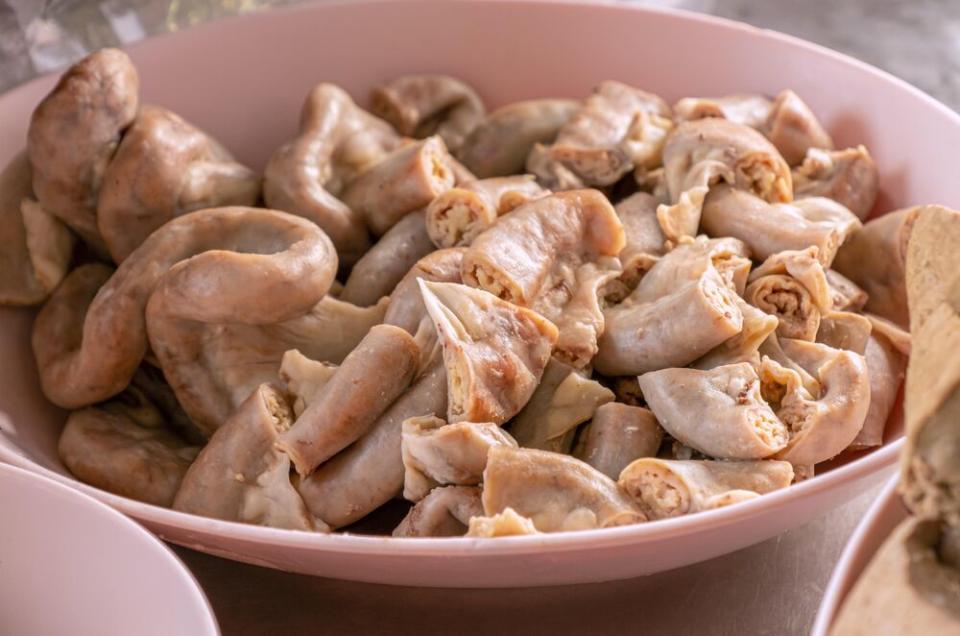What Are Chitlins—And What Are They Made Of?
Hog guts, anyone? Love ‘em or hate ‘em, you can’t deny that chitlins have a flavor and flair that’s all their own. Here’s what you need to know about the divisive Southern staple:
What Are Chitlins?
Chitlins (or chitterlings, if you’re fancy) are cooked pig intestines. While the vast majority of chitlins are pork, sometimes intestines from other animals (particularly cows) are used.
They’re typically boiled, fried, or stuffed with mincemeat and served as just one part of a larger meal.
Chitlins’ pungent scent is intensified by cooking, so they’re often cooked with onions to lessen the intense aroma.
Traditionally, chitlins are associated with soul food.
Chitlins History

Though chitlins’ history in the Southern U.S. goes back pretty far, animal intestines have been consumed around the world for much longer. For instance:
Haggis (boiled sheep’s intestines served in the animal’s stomach) in Scotland
Tricandilles (pig's intestines boiled in bouillon and then grilled) in France
Zarajo (braided sheep's intestines rolled on a vine branch) in Spain
Chinchulín (cow’s intestine) in Latin America
Motsu (fried pig intestines on skewers) in Japan
Like other soul foods, chitlins’ roots in the U.S. are tied to slavery.
In a pre-Civil War era, many slave owners fed their slaves as cheaply as possible. This meant that the master’s household would keep the desirable cuts of pork, while the seemingly unappetizing parts of the pig (snouts, ears, feet, intestines, etc.) would go to the slaves.
What Do Chitlins Taste Like?
Chitlins tend to inspire strong feelings among people who eat them. Whether you love or hate them, you can’t argue that chitlins have a unique flavor.
Their distinct, meaty flavor is almost impossible to describe to someone who has never tasted them. For many people who aren’t fans of chitlins, their thick and sometimes rubber-y texture is more off-putting than the taste.
Are Chitlins Safe to Eat?
WATCH: 5 Raw Chicken Mistakes to Avoid
Chitlins are safe to eat—as long as you handle and clean them very, very carefully.
Pork intestines that are prepared improperly can make you extremely sick with an illness called yersiniosis.
Though anyone who doesn’t wash up thoroughly after coming into contact with affected meat is at risk, young children are more likely to become ill.
Symptoms of yersiniosis—which may persist for several weeks—include fever, abdominal pain, and bloody diarrhea.
Read more: Why Your Beloved Disinfecting Wipes May Be Making Your Kitchen Dirtier
How to Clean Chitlins
If at all possible, purchase pre-cooked chitlins from a butcher. This will help prevent the spread of germs in your household.
If you must purchase raw chitlins to prepare at home, there are some extremely important precautions you should take—food safety, when it comes to chitlins, starts before you even touch the meat:
First thing’s first: According to the CDC, it’s important to keep children out of the kitchen during the cooking process.
Take out everything you’ll need to prepare the chitlins and to clean up when you’re done before you take them out of the packaging. This includes knives, cutting boards, seasonings, pots, pans, colanders, measuring cups, bleach, and paper towels.
Once everything’s on the counter and within reach, you can boil the chitlins for at least 5 minutes to kill as many germs as possible. Drain in a colander.
Thoroughly examine each chitlin for any debris. Look out for straw, hair, undigested food, and fecal matter.
Rinse under cool water, making sure all debris is washed down the drain.
How to Prepare Chitlins
After the chitlins have been cleaned, you can cut or tear them however you want. Most people opt for about 1-inch pieces.
Reminder: It’s at this point you’ll want to sanitize your kitchen again. Make sure everything that’s touched the chitlins is 100% clean—this includes your colander and sink.
If you’re making boiled chitlins:
Boil the meat with whatever spices and seasonings your recipe calls for. Common ingredients are onions, apple cider and/or white vinegar, pepper, salt, garlic, and seasoning salt. Cook in a covered pot for about three hours.
Drain in a (sanitized!) colander and season to taste.
If you’re making fried chitlins:
Boil the chitlins for a few hours to make sure they’re completely cooked and safe to eat before frying.
Coat each piece in a batter made according to your recipe.
Heat two to three inches of oil in a large pot, then fry chitlins until they’re golden and crisp.
Season to taste.

